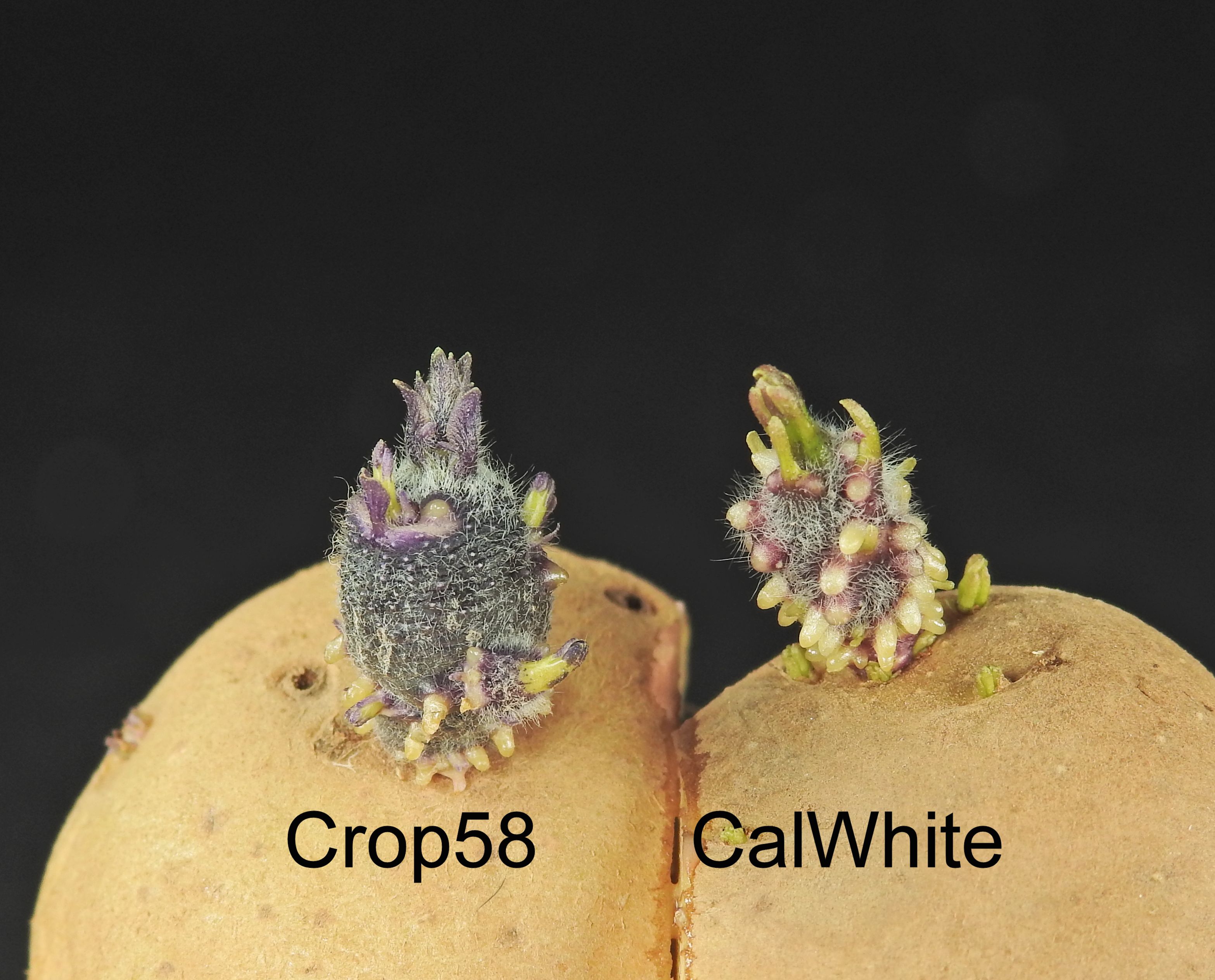Crop58
| Denomination: | 'Crop58' |
|---|---|
| Trade name: | Haylo |
| Botanical Name: | Solanum tuberosum |
| Applicant/Holder: |
The New Zealand Institute for Plant and Food Research Ltd. 120 Mt. Albert Road Mt. Albert Auckland 1025 New Zealand |
| Breeder: |
Russell Genet, Christchurch, New Zealand |
| Agent in Canada: |
Smart & Biggar LP P.O. Box 2999, Station D 55 Metcalfe Street, Suite 900 Ottawa, Ontario K1P5Y6 Canada Tel: 613-232-2486 ex. 1279 |
| Application Date: | 2019-08-13 |
| Provisional Protection:: | 2019-08-13 |
| Application Number: | 19-9983 |
| Grant of Rights Date: | 2024-05-01 |
| Certificate Number: | 7117 |
| Grant of Rights Termination Date: | 2044-05-01 |
Variety Description
Variety used for comparison: 'CalWhite'
Summary: The base of the lightsprout of 'Crop58' has a very strong intensity of anthocyanin colouration while that of 'CalWhite' has a strong intensity of anthocyanin colouration. The lightsprout tip of 'Crop58' has a very strong intensity of anthocyanin colouration while that of 'CalWhite' has a medium intensity of anthocyanin colouration. The lightsprout tip of 'Crop58' has medium to dense pubescence while that of 'CalWhite' has absent or very sparse to sparse pubescence. The stem of 'Crop58' has a high extent of anthocyanin colouration whereas that of 'CalWhite' has a low extent of anthocyanin colouration. The plants of 'Crop58' are shorter than those of 'CalWhite'. The tuber of 'Crop58' has light yellow flesh while that of 'CalWhite' has white flesh.
Description:
LIGHTSPROUT: medium to large, ovoid, medium number of root tips, short lateral shoots
LIGHTSPROUT BASE: very strong intensity of anthocyanin colouration, high proportion of blue in anthocyanin colouration, medium to dense pubescence
LIGHTSPROUT TIP: small in relation to base, closed habit, very strong intensity of anthocyanin colouration, medium to dense pubescence
PLANT: foliage structure is intermediate to leaf type, where foliage is half open to closed and stems are partly visible to not, or hardly, visible, semi-upright growth habit, matures mid-season
STEM: high extent of anthocyanin colouration along entire stem
LEAF: large outline, open, weak presence of secondary leaflets, light to medium green upper side, absent or very low extent of anthocyanin colouration on upper side of midrib, absent or very weak intensity of anthocyanin colouration on upper side of midrib, absent or very low frequency of coalescence of terminal and lateral leaflets
SECOND PAIR OF LATERAL LEAFLETS: very large, leaflet is narrower than long
LEAFLET: absent or very weak degree of waviness of margin, medium depth veins, dull to medium glossiness of upper side, pubescence of blade at apical rosette present
PEDUNCLE: low to medium extent of anthocyanin colouration
INFLORESCENCE: high frequency per plant, medium to large
FLOWER BUD: medium to high extent of anthocyanin colouration
COROLLA: medium to large
COROLLA (INNER SIDE): absent or very weak intensity of anthocyanin colouration, absent or low proportion of blue in anthocyanin colouration, absent or very low extent of anthocyanin colouration
TUBER: oval to long-oval, light yellow flesh
TUBER EYE: shallow, yellow at base
TUBER SKIN: yellow, absent or very weak to weak anthocyanin colouration in reaction to light
Origin & Breeding History: 'Crop58' originated from a cross conducted by the New Zealand Institute for Plant and Food Research Limited in Lincoln, New Zealand in 2001. The cross was made between the varieties 'Karaka', as the female parent, and 'Victoria', as the male parent. Selection of 'Crop58' was initially made in 2002 from the segregating seed population and then maintained as a clone for performance testing. The new variety was assessed over 10 cycles of clonal propagation for yield stability, tuber quality and susceptibility to disease. The tubers were also evaluated for physiological and cooking qualities.
Tests & Trials: The comparative trial for 'Crop58' was conducted by Global Agri Services Inc. in Central Blissville, New Brunswick during the 2022 growing season. The field trial consisted of a single, 22 metre long row per variety. Each row contained 70 plants spaced 0.3 metres apart with inter-row spacing of 1.1 metres. Measurements were taken from 10 plants, or 10 parts of plants, of each variety. The mean difference was significant at the 5% probability level based on a paired Student's t-test. Lightsprout characteristics were assessed on 10 tubers harvested from the comparative trial and observed approximately 2.5 to 3 months after sprouting was promoted by exposing the tubers to an external agent.
Comparison table for 'Crop58' with reference variety 'CalWhite'
Plant height (cm)
| 'Crop58' | 'CalWhite' | |
|---|---|---|
| mean | 57.8 | 72.9 |
| std. deviation | 5.3 | 6.2 |
Click on image for larger view

Potato: 'Crop58' (left) with reference variety 'CalWhite' (right)
- Date modified: